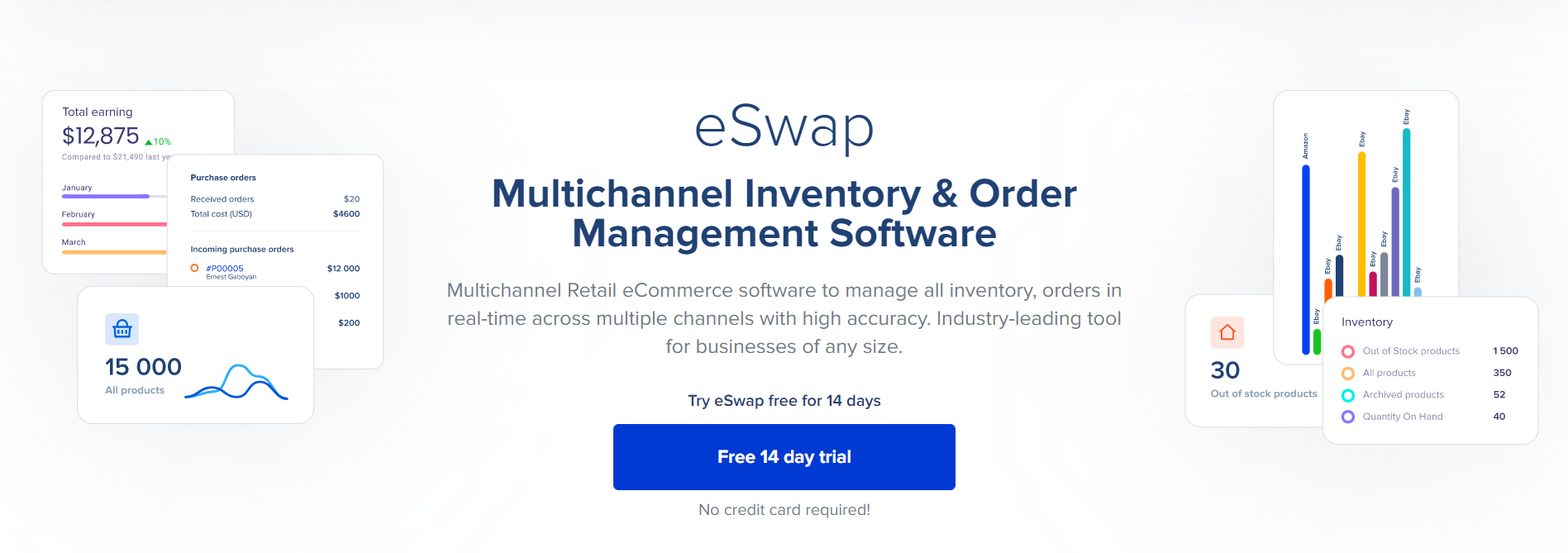Running an eCommerce business is a complex task that involves many different aspects. One of the most challenging points while managing an online store is choosing the proper inventory management technique. The decision you make will affect all your workflow. So, if you get it wrong, your business will reflect that. There are different types of inventory management strategies, and each has its advantages and disadvantages. Choosing one that best suits your needs is possible through trial and error. However, to save you time and money, we have compiled a list of the seven most effective inventory management strategies.

What Is Inventory Management?

Inventory management is all about keeping track and controlling your stock. It includes all the processes starting from manufacturing, buying, storing, and using. The main goal is to have the right product, in the right place, at the right time. Inventory management regulates the inventory flow, ensuring the company has enough stock to meet customer demand.
There are four types of inventory:
- Raw materials
- Work-in-progress (WIP)
- Finished goods
- Maintenance, repair, and operating (MRO)
Why Is Inventory Management Important?
Non-correct inventory management can elevate storage cost, working capital breakdown, waste of resources, and overall supply chain disorder. As a result, the amount of sales drops down, and the number of unsatisfied customers grows. So, inventory management is essential to keep your business running smoothly. It is a vital element of a practical and successfully growing company.
Moreover, an advanced solution will help businesses across the globe to know what is happening in real-time. Besides, it allows a proactive approach to avoid stockouts and other inventory management challenges.
Inventory management as an inseparable supply chain component can be carried out differently. Let’s look at more profound ones to find the best fit for your business.
The Most Advanced and Effective Types of Inventory Management Strategies

There are many types of inventory management strategies. Some are more effective than others and fit different types of businesses. The most popular ones include:
- Just-in-time (JIT) inventory
- ABC inventory analysis
- MRP Method
- Dropshipping
- Bulk shipments
- Backordering
- Consignment
- Cross-docking
- Cycle counting
- EOQ Model
- VED Analysis
- FSN Method
- Minimum Safety Stock
Let’s see how each approach works and what businesses they fit best. We won’t cover every single strategy in-depth, but we will touch on all the important points so you can make an informed decision.
Just-in-Time (JIT) Inventory
Imagine having a manufacturing business. You need to order parts and materials to make your product. The goal of JIT is to receive these orders only when a seller needs them. That way, they don’t have to store anything and tie up their working capital.
JIT is a very effective inventory management strategy. However, it only works if everything runs smoothly. Any delays in the supply chain can cause production to grind to a halt.
If a retailer decides to use JIT, they need to have a very good relationship with their suppliers. Trust and transparency are key elements for JIT inventory. However, if there is no inventory management software, tracking everything and keeping everyone on the same page can be challenging. Using tools like eSwap can help eCommerce retailers stay on top of things and avoid workflow disruptions.
ABC Inventory Analysis
The ABC analysis is a method used to categorize inventory. The acronym for Always Better Control implies that some inventory is more important than others. The ABC analysis is a great way to focus on the items that matter most and manage them accordingly. It involves inventory items according to their classification into three groups (A, B and C).
- The inventory in category A usually includes expensive, high-priced items that are not much in their number. These items are the most controlled ones.
- The items in category B are less expensive than those in group A. Their number is higher, but this inventory, compared to the A category, is moderately controlled.
- And the items of the C category are high in number and require fewer investments and minimum control.
MRP Method
Material Requirements Planning refers to a system determining how much of each raw material is needed to produce a finished product. MRP systems are often used to manage manufacturing processes such as inventory and production.
Inventory management is a vital part of MRP. Businesses can avoid stockouts and other production challenges by keeping track of raw materials, finished products, and work-in-progress products.
While most types of inventory management strategies imply controlling and managing the finished product, MRP emphasizes more on the raw materials. Here the manufacturers first carry out sales forecasting and only then order the inventory.
Dropshipping

Dropshipping is a type of eCommerce business model where businesses sell products without having to carry any inventory. It may sound strange, but it’s a very popular and effective way to do business.
When a customer orders at a dropshipping store, the supplier ships the product directly to the customer’s door. The store owner never has to see or touch the product.
Dropshipping is a great way to start an eCommerce business with little to no upfront investment. It’s also a great way to test new products without carrying inventory risks.
However, dropshipping is not without its challenges. Because you’re not carrying any inventory, you have no control over the quality of the products you sell. Product quality may suffer a lot if the supplier happens to be unreliable.
Bulk Shipments
This inventory management strategy is used when a business buys large quantities of products at once. The idea is to get a discount for buying in bulk and then sell the products individually at a higher price.
Bulk shipments can be a great way to save money on inventory. However, they can also be risky. If an accident happens and the products are damaged, you may be stuck with a lot of inventory you can’t sell.
Backordering
When a customer orders a product that is out of stock, the seller can choose to backorder the product. This means the customer’s order is placed on hold until the product becomes available again. The customer pays for the product upfront and then waits for the product to come back in stock. It is important to inform the customers that their order is on hold and when they can expect it to ship.
Backordering can be very beneficial, but the strategy can be risky because you may end up with a lot of unsold inventory if the product never appears in stock again.
Consignment
Under the consignment inventory management strategy, the seller only pays for the product once it is sold. This means the products are stored at the consignment store until a customer buys them. The store owner does not have to pay for any unsold inventory.
The consignment strategy can be very beneficial because it allows you to test new products without paying for them upfront. However, it can also be risky because you may eventually end up with a lot of unsold inventory that you have to pay for.
Cross-Docking

Cross-docking is a type of inventory management in which products are shipped directly from the supplier to the customer without stopping at a warehouse. This means the retailers don’t need to store their products in a separate location.
Cross-docking can be very beneficial because it eliminates the need for warehousing. However, retailers risk having to pay for products that are damaged in transit. Moreover, if too many products are circulating through the system, it can be challenging to track them.
Cycle Counting
Retailers using cycle counting typically count a certain number of items in their inventory each day. Cycle counting is an effective strategy for businesses oriented towards continuous improvement.
One advantage of cycle counting is that it allows businesses to keep track of their inventory without interruption. However, the strategy can be time-consuming and may not be accurate if items are moved around the warehouse frequently.
EOQ Model
EOQ is the Economic Order Quantity inventory management technique. The main focus of attention becomes quantity. A company should make the right decisions about how much inventory to order at a particular point. Here when reaching the minimal inventory level, the responsible person reorders items. Order costs and carrying costs become lower with the help of this EOQ model. Hence the EOQ model ensures the right quantities when needed.
VED Analysis
The next inventory management strategy type is VED standing for Vital Essential and Desirable. It is mainly concerned with some additional inventory parts. There are extra elements that the whole process cannot operate without. For example, components essential for products are usually costly. Additionally, any company can have a low inventory level for desirable parts, which are not often necessary for production.
FSN Method
FSN stands for Fast, Slow and Non-moving inventory. This is one of the most popular methods of inventory control. It is beneficial for controlling obsolescence. Of course, not all items are similar. Some are used more, thus needing to be updated frequently. In contrast, the others are not necessary at all. Therefore, according to this method, inventory can be classified into three groups.
- Fast-moving inventory,
- Slow-moving inventory,
- Non-moving inventory.
Minimum Safety Stock
And the last one from the list of the most effective types of inventory management strategies refers to the safety stock. It is the level of inventory with the help of which businesses avoid stockout. Companies place the new order beforehand when using the minimum safety stock, especially when the existing inventory isn’t over yet.
For example, a company’s total inventory is 18,000 units, and a new order arrives when the inventory reaches 15,000 units. In this case, 3,000 units of inventory are part of the minimum safety stock level.
Inventory Management Software Integration

Digitization is a beneficial strategy for any field, including inventory management. Integrating all your inventory data in a single software is a quick and convenient format for tracking your inventory, warehouse, orders, and other essential aspects of the eCommerce business.
One of the tools that can allow you to do that is eSwap, the inventory management software which allows you to utilize many features with just a few clicks. The main features of the platform include:
Explore the other software opportunities, and don’t hesitate to link your business to a quality online tool that will maximize the effectiveness of any strategy you choose.
As already mentioned, inventory management is an essential part of every business. With the help of effective inventory management systems, companies can reduce their warehousing costs, inventory carrying charges, ordering costs, cost of obsolescence, etc. As a result, it improves the whole supply chain of the business. So, it is vital to take all the necessary steps to maintain an adequate inventory management and control system. While looking for a reliable method, remember to choose one that will fit your business’s needs and help you reach your professional aspirations!







